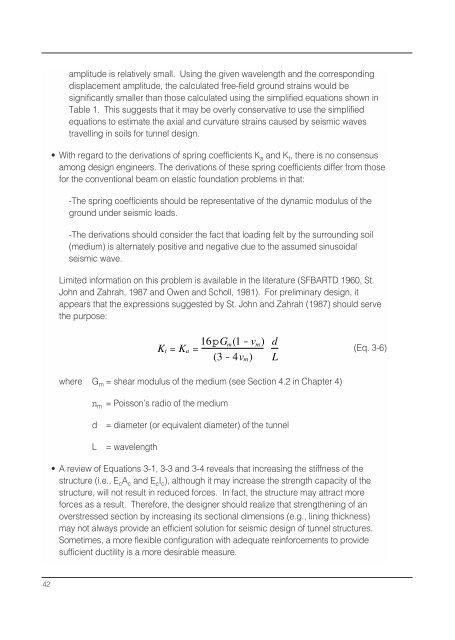Seismic Design of Tunnels - Parsons Brinckerhoff
Seismic Design of Tunnels - Parsons Brinckerhoff
Seismic Design of Tunnels - Parsons Brinckerhoff
You also want an ePaper? Increase the reach of your titles
YUMPU automatically turns print PDFs into web optimized ePapers that Google loves.
amplitude is relatively small. Using the given wavelength and the corresponding<br />
displacement amplitude, the calculated free-field ground strains would be<br />
significantly smaller than those calculated using the simplified equations shown in<br />
Table 1. This suggests that it may be overly conservative to use the simplified<br />
equations to estimate the axial and curvature strains caused by seismic waves<br />
travelling in soils for tunnel design.<br />
• With regard to the derivations <strong>of</strong> spring coefficients K a and K t , there is no consensus<br />
among design engineers. The derivations <strong>of</strong> these spring coefficients differ from those<br />
for the conventional beam on elastic foundation problems in that:<br />
-The spring coefficients should be representative <strong>of</strong> the dynamic modulus <strong>of</strong> the<br />
ground under seismic loads.<br />
-The derivations should consider the fact that loading felt by the surrounding soil<br />
(medium) is alternately positive and negative due to the assumed sinusoidal<br />
seismic wave.<br />
Limited information on this problem is available in the literature (SFBARTD 1960, St.<br />
John and Zahrah, 1987 and Owen and Scholl, 1981). For preliminary design, it<br />
appears that the expressions suggested by St. John and Zahrah (1987) should serve<br />
the purpose:<br />
K t = K a = 16pG m(1 - v m )<br />
(3 - 4v m )<br />
d<br />
L<br />
(Eq. 3-6)<br />
where G m = shear modulus <strong>of</strong> the medium (see Section 4.2 in Chapter 4)<br />
n m = Poisson’s radio <strong>of</strong> the medium<br />
d<br />
L<br />
= diameter (or equivalent diameter) <strong>of</strong> the tunnel<br />
= wavelength<br />
• A review <strong>of</strong> Equations 3-1, 3-3 and 3-4 reveals that increasing the stiffness <strong>of</strong> the<br />
structure (i.e., E c A c and E c I c ), although it may increase the strength capacity <strong>of</strong> the<br />
structure, will not result in reduced forces. In fact, the structure may attract more<br />
forces as a result. Therefore, the designer should realize that strengthening <strong>of</strong> an<br />
overstressed section by increasing its sectional dimensions (e.g., lining thickness)<br />
may not always provide an efficient solution for seismic design <strong>of</strong> tunnel structures.<br />
Sometimes, a more flexible configuration with adequate reinforcements to provide<br />
sufficient ductility is a more desirable measure.<br />
42
















